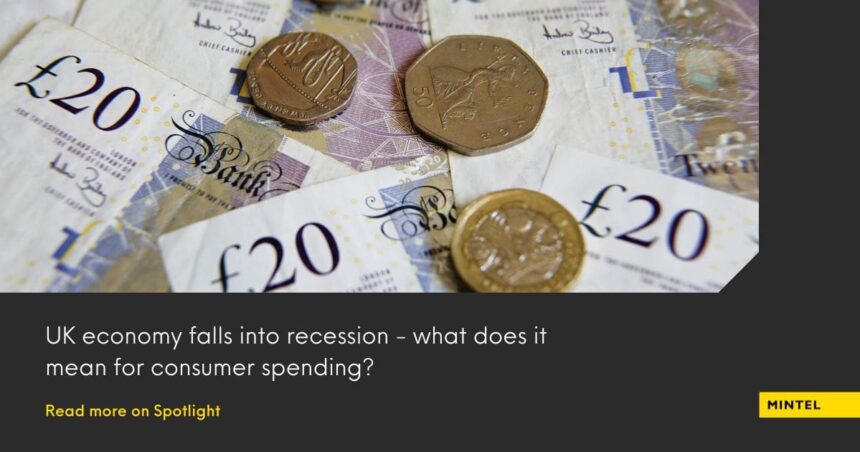The UK slipped into a technical recession in the final quarter of 2023 according to new data from the Office of National Statistics (ONS). The fall in economic output was steeper than most economists expected, with the economy barely growing over the course of last year.
Despite the slowing economy, consumer confidence is up on mid-2023 levels. Rising real wages is one factor behind this resilience. But another is that consumers have honed their survival skills after half a decade of constant upheaval. The fall in GDP is a side-issue compared to the impact of COVID-19 and the cost of living crisis. And similar to the income squeeze that followed the financial crisis, savvy shopping doesn’t mean that people are cutting back across the board. From food to beauty to travel, many are still prepared to trade up for the right product.
Bleak economic and consumer outlook for 2024
While economists and consumers don’t always agree with each other, there’s one area where there is consensus: the UK’s economic prospects. Most economists expect growth to stagnate in 2024, rising by a few percentage points. Consumers are only marginally more optimistic. Only 11% expect the economy to grow significantly, compared to 38% who think it’ll stay about the same.
For most consumers, wages matter more than economic output
The term ‘recession’ still has power. But for most people, it’s the symbolism that matters, not the measure itself. In the real world, a 0.3% decline isn’t going to feel any different than a 0.3% increase.
What really matters is how much money you’ve got left in your bank account at the end of the month. And here, falling real wages means that for many people it has felt as if we fell into recession much longer than six months ago. Crucially, this measure has turned around over the last six months. Ever since mid-2023, average wages have been edging ahead of the rate of inflation, meaning that people finally have a little bit more slack in their budget.

Look past the economic data to really understand consumer behaviour
Brands need to focus on issues directly impacting their customers to understand the consumer economy.
Despite the fall in national economic activity over the second half of 2023, 28% of consumers say that their finances are healthy, and 44% that they’re at least doing OK. This headline data hides significant variation across different demographic groups, of course: 21% of people who have a household income of less than £15,500 are either struggling or are already in financial trouble, compared to just 2% of people earning at least £50,000.
Looking at the longer-term trend in financial wellbeing, the disconnect between GPD and consumer sentiment becomes even more clear. Our January data did show a fall in sentiment, but we saw a similar post-Christmas dip in 2021 and 2022. The medium-term trend, though, is broadly positive, and sentiment ended 2023 higher than at any point since mid-2022.
Cost of living – still shaping consumer behaviour
Although sentiment is holding up well, the cost of living crisis is still having a significant impact on consumer spending. The large majority of consumers are still changing their behaviour in response to rising prices: 34% are shopping more at low-cost retailers, while 32% are shifting to private label, and 43% are being more careful about spending on luxuries.
The changes are even more pronounced among the people who have been hardest-hit by the crisis: 67% of people who are struggling to make ends meet say that they’re reducing energy use at home, for example.

Consumers still cautious – but there’s room to splash out
Economists talk about ‘the paradox of thrift’: the tendency for consumers to cut spending just as the economy needs a boost. Mintel’s data shows that consumers are cautious. Half (50%) of people added to their savings in the last three months, while spending on big-ticket categories like domestic appliances and cars is still subdued.
But responses also confirm that there’s room for discretionary spend, whether that’s new clothes, a meal out, or a trip abroad.
Retail: Hope for loosening of purse strings in second half of 2024

“Many people had already been acting as if the UK economy was in a shallow recession, and in the first half of 2024 there is little to suggest a material shift in retail spending intention.”
Nick Carroll, Category Director – Retail Insights
Rising prices have meant that consumers have had little option but to increase their total spending, but they’re attempting to minimise the impact by cutting back on luxuries, and switching to private label or lower-cost retailers.
The news of a technical recession is unlikely to materially shift consumer behaviour in the retail sector. As in the post-financial crisis years, savvy shopping is now engrained, and will take years to unwind. Many people had already been acting as if the UK economy was in a shallow recession, and in the first half of 2024 there is little to suggest a material shift in retail spending intention, particularly in big-ticket categories.
Christmas 2023 hints at how polarised any improvement in retail spending will be in 2024. Average spending on gifting fell 5% year-on-year, and gift spending for mid-income households (£25k-£49.9k), dipped by 14%. Any increase in confidence ahead of Christmas was counterbalanced by continued fear around interest rates and a general air of caution.
However, high income shoppers grew spend (+11% y-o-y), and we saw more purchasing in high ticket categories like electricals, jewellery and watches.
The hope is further easing of inflation and continued wage growth will allow finances additional time to recover, and that in the second half of the year we may see a broader range of consumers’ act in the way we saw a proportion of high earners do during Christmas 2023, upping discretionary spend and releasing the purse strings a little.
Food & Drink: Big change already happened, but still opportunities for premium
Kiti Soininen, Category Director – Food & Drink
Food and drink shopping habits have already changed significantly during 2022 and 2023.
High inflation in the category, its large share in household budgets and the ability to make immediate changes to shopping habits have already made food and drink a prime candidate for behavioural changes, so the news of a technical recession is unlikely to bring further disruption.
The changes in behaviour have been most obvious in pricier segments like meat substitutes and chilled ready meals, and discretionary items like desserts, where volume sales fall in 2023.
The boost to own-label market share in most categories speaks to the same trend. However, people still want to treat themselves. In fact, 49% of adults bought premium alcoholic drinks in the 12 months to October 2023, including 42% of those describing their finances as tight/struggling.
This continues to create opportunities for premium products. Among recent examples, premium brands Charlie Bigham’s and Wasabi outperformed the chilled ready meals segment in 2022/23, while brands at the higher end of mass-market like San Miguel and Corona were among star performers in lager.

Travel: Demand is still strong, but booking patterns reflect squeezed budgets
Paul Davies, Category Director – Travel and Leisure
The message across travel, leisure and foodservice continues to be that consumers are still keen to splash out on these experiences, but that many are having to prioritise. People are still booking holidays and eating out, but they’re doing these things less often than in the past.
The upside is that when they do these things they are willing to spend more than ever before in order to ensure they have a high quality experience.
For instance the average price of both domestic and overseas holidays reached a record high in 2023 – driven partly by rising prices (and consumers’ willingness to pay more), but also by a changing mix as consumers prioritise their main holiday over short, top-up breaks.
We’re expecting this trend to continue in 2024 with the value of the overseas holiday market set to grow by 7.5% to reach £52 billion.
Beauty & Personal Care: Everyday indulgence continues to support demand
Samantha Dover, Category Director – Beauty & Personal Care
In line with previous recessions, spending across most beauty and personal care categories remains buoyant, as consumers remain willing to invest in their appearance, and turn to these products to lift their spirits.
This is true even at the premium end of the market. In 2023, Mintel estimates value sales of prestige beauty and personal care products increased 6.4%. Innovation attracted new users to the sector, and prevented existing users from completely abandoning it.
However, savvy shopping is having an impact even in this recession resistant sector. Two-thirds (66%) of prestige beauty consumers said that the cost of living had led them to reduce the number of products they buy. While people aren’t abandoning the category, they are becoming more selective, and many will likely be opting for lower-priced prestige brands.
To find out more about the prospects for brands, consumer and the UK economic outlook please click here for a more a detailed assessment by Mintel’s experts.








